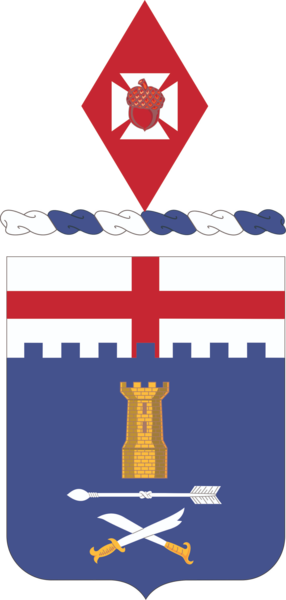11th Infantry Regiment, US Army: Difference between revisions
Knorrepoes (talk | contribs) m (Text replacement - "Literature: Image from Wikimedia Commons↵↵↵Category:Military heraldry of the United States" to "Image from Wikimedia Commons {{us}} {{media1}} Category:Military heraldry of the United States") |
Knorrepoes (talk | contribs) m (Text replacement - "The Coat of Arms was " to "The arms were ") |
||
| Line 22: | Line 22: | ||
The shield is blue for infantry. Service in the Spanish War is shown by the castle and in the Indian Wars by Satanta's "arrow. "The most important Indian campaign of this regiment was against the Kiowas, Comanches and Cheyenne in 1874. Satanta was a noted Kiowa chief who died just previous to this campaign. His "arrow" was really a spear with feathers on the end and a handle. The kampilan and bolo represent engagements against the Moros of Mindanao and the Filipinos of the Visayas. Service in the World War is shown by the chief bearing the cross of the ancient Lords of Dun tocommemorate the crossing of the Meuse at Dun. The embattled partition represents the siege of Chattanooga in 1863. The crest consists of the Civil War badges of the 1st Division, 14th Army Corps and 2nd Division, 5th Army Corps, and the World War 5th Division shoulder sleeve insignia. | The shield is blue for infantry. Service in the Spanish War is shown by the castle and in the Indian Wars by Satanta's "arrow. "The most important Indian campaign of this regiment was against the Kiowas, Comanches and Cheyenne in 1874. Satanta was a noted Kiowa chief who died just previous to this campaign. His "arrow" was really a spear with feathers on the end and a handle. The kampilan and bolo represent engagements against the Moros of Mindanao and the Filipinos of the Visayas. Service in the World War is shown by the chief bearing the cross of the ancient Lords of Dun tocommemorate the crossing of the Meuse at Dun. The embattled partition represents the siege of Chattanooga in 1863. The crest consists of the Civil War badges of the 1st Division, 14th Army Corps and 2nd Division, 5th Army Corps, and the World War 5th Division shoulder sleeve insignia. | ||
The | The arms were approved 12 October 1920. | ||
Revision as of 05:30, 28 December 2022
11TH INFANTRY REGIMENT, US ARMY
 (Coat of Arms) |
(Distinctive Unit Insignia) |
Official blazon
Shield: Azure, Satanta's arrow in fess Argent between in chief a castle Or in base a kampilan and bolo in saltire of the second hilted of the third. On a chief embattled of the second a cross Gules.
Crest: On a wreath of the colors a fusil Gules bearing a cross patée Argent charged with an acorn of the first.
Motto: SEMPER FIDELIS (Always Faithful).
Origin/meaning
The shield is blue for infantry. Service in the Spanish War is shown by the castle and in the Indian Wars by Satanta's "arrow. "The most important Indian campaign of this regiment was against the Kiowas, Comanches and Cheyenne in 1874. Satanta was a noted Kiowa chief who died just previous to this campaign. His "arrow" was really a spear with feathers on the end and a handle. The kampilan and bolo represent engagements against the Moros of Mindanao and the Filipinos of the Visayas. Service in the World War is shown by the chief bearing the cross of the ancient Lords of Dun tocommemorate the crossing of the Meuse at Dun. The embattled partition represents the siege of Chattanooga in 1863. The crest consists of the Civil War badges of the 1st Division, 14th Army Corps and 2nd Division, 5th Army Corps, and the World War 5th Division shoulder sleeve insignia.
The arms were approved 12 October 1920.
Image from Wikimedia Commons
US heraldry portal
This page is part of the US heraldry portal |
Heraldry of the World |
|
US heraldry:
|
Ecclesiastical Heraldry of the USA:
Military Heraldry: |





